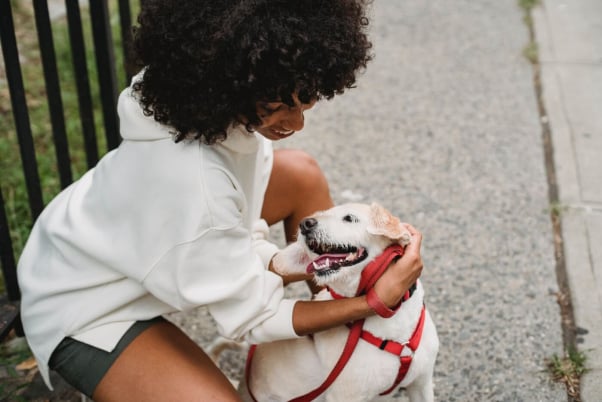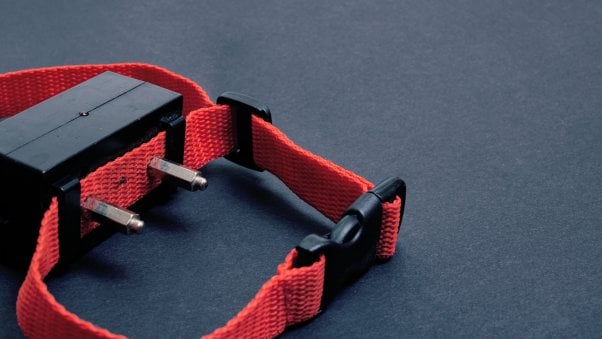A dog collar and leash used alone on walks can be bad for dogs’ physical and emotional well-being, and some types of collars control dogs through pain and fear.
Read on to find out what you should be using instead of a dog collar alone to keep your canine companion happy, healthy, and safe on walks.
Are Collars Ever OK?
Using a simple buckle collar to hold a dog’s ID and license tags is a great idea, but dragging your furry buddy along by the neck is not. Being leashed by the neck during a walk, even with a buckle collar, can be harmful to dogs who pull or lunge, especially if their guardian jerks on the leash. Also, dogs with wide necks can easily slip out of buckle collars. Certain types of collars can even cause psychological distress. Collars should be worn outdoors for identification purposes only, not as a means of control.

Harnesses Are Best
When it comes to safety and comfort, using a harness is always better than a collar. There are many kinds of harnesses to choose from. If your dog pulls, try the Sense-ation harness or one made by Walk Your Dog With Love. Both products have a front leash attachment, which aids in redirecting a lunging dog back toward you. They are comfortable and can really help curb strong pulling without harming your dog. If excessive pulling isn’t an issue, then a standard nylon-web H-style harness might be just the ticket, like those by Baydog. For tiny dogs, there is a soft, comfy little harness called the Puppia.
For information on encouraging your dog to walk calmly on a leash using a positive approach, check out PETA’s tips on choosing a dog trainer, the book My Dog Pulls—What Do I Do? by Turid Rugaas, or her DVD.
Types of Dog Collars That Are Inherently Cruel
Choke Collars
These collars can be extremely dangerous to dogs. Their use has been associated with the following:
- whiplash
- fainting
- spinal cord injuries
- paralysis
- crushing of the trachea
- partial or complete asphyxiation
- crushing or fracture of the bones in the larynx
- dislocation of the vertebrae in the neck
- bruising of the esophagus
- damage to the skin and tissue of the neck
- prolapsed eyeballs
- brain damage
Choke collars can also lead to sudden death. This was the case with a small dog, Peanut, at a doggy daycare in Manhattan.
But physical harm is not the only risk—the use of choke collars can also have psychological consequences. Imagine if you were choking, with a chain around your neck. You, too, would be frightened and react aggressively. And how would you feel about the person doing this to you? Would you ever trust them again?
Prong Collars
The painful metal prongs on these collars pinch the skin around dogs’ necks when they pull and can scratch, bruise, or puncture it. As with choke collars, dogs may interpret the tightening of a prong collar around their neck as a stranglehold and become fearful and/or aggressive. There are several reported incidences of prong collars becoming embedded in dogs’ necks. Nini was found running loose with a prong collar embedded in her skin, the wound oozing blood and pus. Thankfully, she was rescued and later found a new, loving home, and her previous guardian was cited for cruelty to animals.
E-Collars and Shock Collars
E-collars used to be known as shock collars, but companies rebranded them when the term “shock collar” became less acceptable to the public. Many stores refuse to sell the cruel products.
E-collars can cause your dog serious physical and emotional harm. The painful and confusing shocks they deliver are meant to discourage dogs from engaging in “bad” behavior but often just confuse and scare them. Dogs may learn to associate the pain with whatever is occurring in their immediate surroundings, or they may realize that their guardian is shocking them and become fearful. This type of training destroys trust. When dogs fear and distrust humans their stress increases and it can lead to aggression, among other serious problems.
A couple in Singapore experimented on themselves with shock and prong collars to see what they were inflicting on their dog and were appalled by the psychological and physical toll the devices exacted—largely because of the unpredictable timing of the next painful shock. The anxiety and confusion caused by repeated and unexpected shocks can lead to changes in a dog’s heart and respiratory rates and may even cause gastrointestinal disorders and atrial fibrillation. Shock collars can also malfunction, either administering nonstop shocks, causing burns, or delivering no shocks at all.
E-collars are often used in conjunction with electric “invisible” fences. A wire is buried underground, and it serves as an unseen boundary that will inflict a shock if the dog crosses it. The fear of getting shocked may keep dogs inside a yard, but it cannot prevent other animals or people with bad intentions from entering and approaching your dog. Some dogs cross the line and take the pain because something is motivating them to do so (for example, a squirrel or a cat), but then they can’t get back in.
History of the Dog Collar
Why were dog collars invented in the first place? Did you know that the roots of dog collars go back thousands of years?
According to the Ancient History Encyclopedia, dogs are depicted wearing collars and leashes in antiquity artwork around the globe—from Rome to Mesopotamia to China. When the Mesopotamians urbanized dogs 5,300 years ago, collars and leashes were created to keep dogs safe and to demonstrate how integral they were to daily life. While collars were used to keep dogs close, many were purely decorative, adorned with protective amulets that were thought to ward off evil.
Our modern choke, prong, and e-collars don’t ward off evil—they are evil. These atrocities belong in the dustbin of history, and dog guardians should opt for a modern comfy harness instead.









